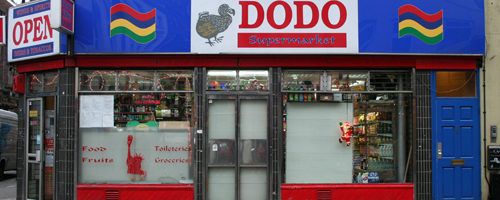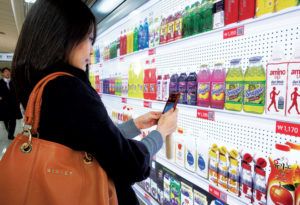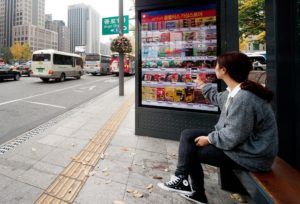Supermarkets, going the way of the dodo?

With the advent of online groceries shopping such as Amazon Fresh, could supermarkets face the same fate of Blockbuster and Borders? Groceries retailers are mixing new technologies and old traditions to evolve and avoid extinction.
In the past ten years, the retail landscape worldwide has changed dramatically. Some businesses, such as video rentals and record stores disappeared when disruptive new technologies eliminated the need for brick-and-mortar stores. Others, like general computer stores and most bookstores have been displaced by online shopping and specialty brand stores. Popular brands like Blockbuster, Tower Records, and Borders have disappeared and most people under 21 won’t even know what they were [1] [2].
With the advent of online groceries shopping, could the same fate happen to your neighborhood’s supermarket? Will the groceries business end up controlled by Amazon and similar companies? The digital menace is real, and groceries companies know it. However, they are embracing digital innovations to strike back and stay as relevant players in their business.
Consumers evolve
Consumer have embraced e-commerce and groceries shopping is no exception. According to Nielsen, one quarter of groceries shoppers already order groceries online and more than half are willing to do it in the future [3]. This has been impulse mainly by Millennials and Generation Z, who have little time and preference to avoid time-consuming chores and prefer to invest their time in meaningful experiences.
This trend is not exclusive of developed economies. Emerging markets such as Asia-Pacific and Latin America are avid for e-commerce, more so than Europe and North America. For example, while 66% of shoppers in Asia-Pacific are willing to use virtual supermarkets such as Amazon Fresh only 46% have the same interest in Europe [4].
However, consumers have not migrated massively to groceries e-commerce without concerns. Old habits die hard and groceries shopping has been for decades a sensorial and social experience [5]. People are more likely to buy non-food products (beauty, cleaning products) online than fresh food. Shoppers fear receiving fruits and produce they would not have chosen had they been in the store, and smelling a freshly baked apple pie is not the same as seeing one through the Instacart app. In addition, most online shoppers have also felt the unpleasant experience of late deliveries or receiving products that don’t exactly match the online description of the products.
Wi-Fi in Aisle Four
To avoid extinction, groceries retailers have started to create a new retail experience for the future. Considering both the willingness of consumers to switch to online shopping and the resistance to shop certain products on the web, retailers are transforming their operation to give the customer the best from their brick-and-mortar stores and the online environment. Under this new approach, retailers are creating an “omni-channel” [6] experience where consumers can transfer between digital and physical channels of the company according to their preferences and the type of purchase [7].
 Two retailers have started to work in how the supermarket of the future might look like. Tesco, a global retailer based in the UK, has invested heavily in technology development, including a new 3000-worker development center in India. Tesco’s shoppers can now order their products online and pick them up in most of their UK stores. In Seoul, consumers can shop w ith their smartphone from a virtual store in a subway station or a bus stop and then select if they want to pick their products at a real store or pay for a delivery service (see images). The company is also using shopping pattern data at their stores, obtained from their loyalty program, to select the best product-mix for each store [8].
Two retailers have started to work in how the supermarket of the future might look like. Tesco, a global retailer based in the UK, has invested heavily in technology development, including a new 3000-worker development center in India. Tesco’s shoppers can now order their products online and pick them up in most of their UK stores. In Seoul, consumers can shop w ith their smartphone from a virtual store in a subway station or a bus stop and then select if they want to pick their products at a real store or pay for a delivery service (see images). The company is also using shopping pattern data at their stores, obtained from their loyalty program, to select the best product-mix for each store [8].
Coop, in Italy, worked with Microsoft and Intel to create the brick-and-mortar store of the future. Introduced at the Expo Milan in 2015, Coop’s new store model relies  heavily on technology to create a personalized shopping experience that resembles the town market experience decades ago[9]. By just looking at a product, consumers get detailed information of it in screens located nearby including “ingredients, origin, carbon footprint, and wine pairing recommendations” [10], creating an experience that is more than just a chore. All of this is possible thanks to motion sensors, like those found in an Xbox, located through the supermarket. The sensors help identify which products the shopper looks and selects, also helping Coop to keep an instantaneous inventory of the products on the shelves [11] More information about Coop’s proposal is available at http://supermercatodelfuturo.e-coop.it/eng.
heavily on technology to create a personalized shopping experience that resembles the town market experience decades ago[9]. By just looking at a product, consumers get detailed information of it in screens located nearby including “ingredients, origin, carbon footprint, and wine pairing recommendations” [10], creating an experience that is more than just a chore. All of this is possible thanks to motion sensors, like those found in an Xbox, located through the supermarket. The sensors help identify which products the shopper looks and selects, also helping Coop to keep an instantaneous inventory of the products on the shelves [11] More information about Coop’s proposal is available at http://supermercatodelfuturo.e-coop.it/eng.
It’s still premature to know which of all these innovations will become mainstream in years to come. Some technologies might work in some markets but not in others. The experience of the music industry, with many promising devices and applications now extinct (think Rdio…) may give an example of what will happen in retail. However, there’s little doubt retailers must keep investing to adapt to the changes in preferences of consumers while still respecting old shopping traditions. It’s a matter of survival.
Word count: 772
[1] “15 most memorable companies that vanished”, NBC News, http://www.nbcnews.com/id/41027460/ns/business-us_business/t/most-memorable-companies-vanished/#.WC5-IvkrIhc, Accessed November 2016.
[2] “8 iconic brands that have disappeared”, Fortune, November 9th 2014, http://fortune.com/2014/11/09/defunct-brands/, Accessed November 2016.
[3] Nielsen, “The Future of Grocery”, April 2015, https://www.nielsen.com/content/dam/nielsenglobal/vn/docs/Reports/2015/Nielsen%20Global%20E-Commerce%20and%20The%20New%20Retail%20Report%20APRIL%202015%20(Digital).pdf, Accessed November 2016.
[4] Ibid.
[5] McKinsey & Company, “Finding your digital sweet spot”, November 2013, http://www.mckinsey.com/business-functions/digital-mckinsey/our-insights/finding-your-digital-sweet-spot, Accessed November 2016.
[6] McKinsey & Company, “Retail 4.0: The Future of Groceries in a Digital World”, https://www.mckinseyonmarketingandsales.com/sites/default/files/pdf/Future_of_grocery_in_digital_world.pdf, Accessed November 2016.
[7] Boston Consulting Group (BCG), “The Digital Future: A Game Plan for Consumer Packaged Goods, https://www.bcgperspectives.com/content/articles/digital_economy_consumer_products_digital_future_game_plan_consumer_packaged_goods/?chapter=2, Accessed November 2016.
[8] Tom Farre, Tesco’s Retail Bet: All-in with Digital, CA Technologies , August 13th 2014, http://www.ca.com/us/rewrite/articles/application-economy/tescos-retail-bet-all-in-on-digital.html, Accessed November 2016.
[9] Accenture Consulting, “Coop Italia: Transforming the customer experience with Supermarket of the Future”, https://www.accenture.com/us-en/success-coop-italia, Accessed November 2016.
[10] Susanna Ray, The supermarket of the future: Designing for humans, Microsoft, https://blogs.microsoft.com/transform/feature/the-supermarket-of-the-future-designing-for-humans/#sm.00001ihbg4b1kuetdwys5ypf8x6gf, Accessed November 2016.
[11] Ibid.



As someone looking into working at a traditionally brick and mortar supermarket chain this summer, this article was both terrifying and exciting! On one hand, there may not be much these retailers can do to survive, on the other hand, when their back is against the wall is likely when they will have to innovate the most to stay alive and relevant. As I look into working at one of these retailers over the summer, I will definitely be looking out for projects that involve this digital transformation. I think you are right that it is not a matter of if they will look into this space, but whether they will do it soon enough and well enough to survive!
Thank you for such a fascinating post! I completely agree with you that supermarkets are facing many challenges today, and really liked the examples you gave of what retailers such as Tesco and Coop are doing to digitize their businesses. I do wonder though, if large supermarket chains will be able to move quickly enough to be able to compete in the future. For instance, over the past two years, three U.S. supermarket chains have declared bankruptcy: Fairway, A&P and Haggens. With the digitization of supermarkets, and the ability to order groceries online, I think that supermarket of the future will need to be much smaller, and provide services in addition to groceries, such as entertainment and dining [1]. For large, established supermarket chains, I wonder about their ability to fund and move quickly enough to embrace a digital “supermarket of the future.”
[1] “Top Trends in Grocery Shopping for 2016 Announced,” PR Newswire, December 28, 2015, http://www.prnewswire.com/news-releases/top-trends-in-grocery-shopping-for-2016-announced-300197266.html, accessed November 2016.
This was a very interesting read, thank you! While I’ll continue to be a luddite and go to grocery stores and farmers’ markets well into the future, I’m the last one among my housemates who’s resisted the pull of Instacart (a start-up that allows customers to choose their groceries through a mobile app and have them delivered within an hour or two). I wonder if supermarkets will all need to build their own logistics networks in the future, or if they will eventually all need to partner with the few surviving intermediaries to provide delivery services, lest they be disintermediated by Amazon.